Without tracking where your pages appear in search, it’s hard to know if your strategy is effective.
Semrush's Position Tracking tool eliminates the guesswork.
You’ll see exactly where your web pages rank for specific keywords across devices, locations, and even search engines (including ChatGPT).
In this guide, we’ll walk through how to use Position Tracking to:
- Set up tracking for your web pages across devices, locations, and search engines
- Compare your search visibility against competitors to identify opportunities
- Win high-value SERP features like featured snippets and local packs
- Organize your data and create professional reports that demonstrate SEO progress
Let’s take the guesswork out of your SEO.
Track Local Rankings with Targeting Down to ZIP Codes
If you own a local business like a restaurant or repair shop, you need to know how well you show up in searches from all of your service areas.
And checking your rankings manually won’t show you the full story.
For example, if someone searches "pizza delivery near me" from different parts of town, your pizza shop might show up #1 in some areas but not appear at all in others.
Position Tracking lets you check your rankings by specific ZIP codes, so you can:
- See exactly where your business appears in local searches
- Find neighborhoods where people can't find you online
- Focus your efforts on areas with the most potential customers
To create a new Position Tracking campaign and enter the location you want to track in the “Location” search bar.
You can enter a country, state/region, city, or ZIP code.
If you’re a local business, enter the ZIP code or area where you want to reach customers.

Add your keywords and click “Start Tracking.”
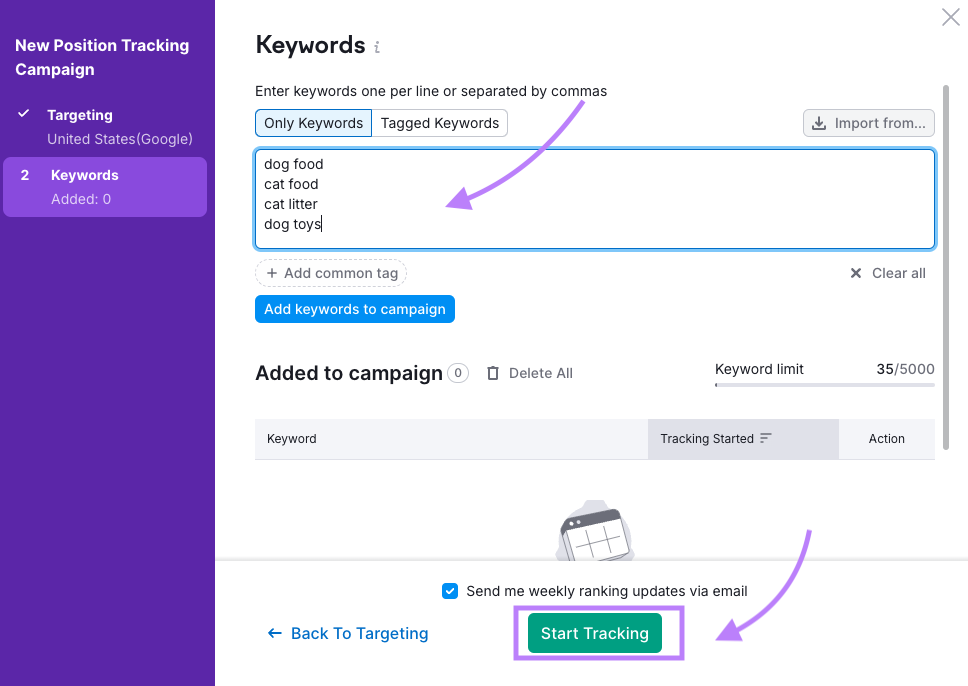
Once your Position Tracking campaign is set up and collecting data, you’ll see a Landscape report detailing the following:
- Campaign Header: Shows your domain, location (like "Austin, Texas"), search engine that you’re tracking, and language
- Key Metrics: View Share of Voice percentage, Estimated Traffic, and Average Position with change indicators
- Rankings Distribution: Visual chart showing how many keywords rank in positions 1-3, 4-10, 11-20, and 21-100
- Keyword Performance: Track positions for specific keywords with metrics showing improvements and declines
- Location Verification: Your tracked location appears in the dashboard header

You can verify that your tracking is working by checking the location indicator in the dashboard header and reviewing the location-specific ranking data for your keywords.
Track Local Pack Performance
For local businesses, appearing in the Local Pack (the map with business listings) can drive significant foot traffic and calls.
Position Tracking helps you monitor your visibility in this critical space.
This lets you:
- See which of your target keywords trigger Local Pack results
- Track your visibility and positions in those Local Packs
- Identify opportunities to improve your Local Pack rankings
Here’s how to set it up.
In the setup wizard, enter your business name as it would appear in the local pack. This helps Semrush identify your listing.
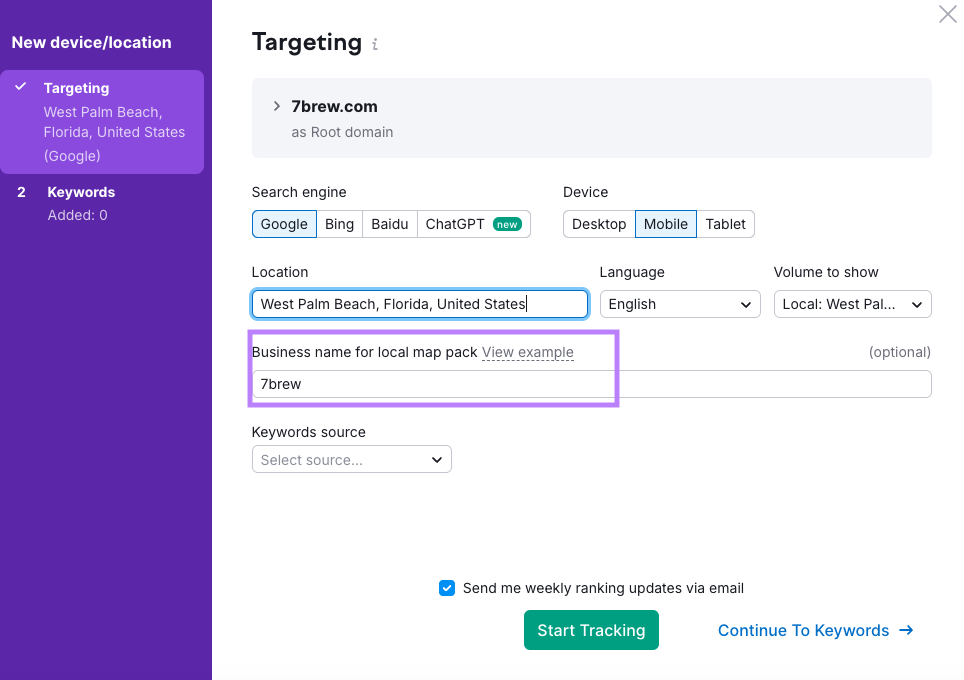
Once your tracking is set up, you can filter your reports by the "Local Pack" SERP feature.

Use this filter to see:
- Target keywords with local packs on the SERP
- Target target without local packs on the SERP
- Local packs where your website ranks
- Local packs where your website does NOT rank
Choosing the last option helps you identify your biggest local SEO opportunities: keywords with local packs where you currently do not rank within them.
Some efforts that help with local SEO include:
- Google Business Profile Optimization: Regularly update your Google business profile to ensure all information is accurate and reflects your current operations.
- Consistent NAP Data: Ensure your name, address, and phone number (NAP) are consistent across all online platforms and listings. Inconsistencies can undermine your SEO efforts and reduce your chances of appearing in Local Packs.
- Effective Citation Management: Actively manage your citations to keep your business information uniform across all directories and listings.
Monitor Rankings by Device or Search Engine
Search results can look completely different on your phone compared to your computer. And results can change depending on which search engine you use.
Here's how these variations can impact your website's visibility:
- Device Variability: Your website might rank on the first page of Google when searched on a desktop, but it could drop to the second or third page on mobile devices—where fewer people are looking.
- Search Engine Differences: Google and Bing have traditionally dominated the search engine landscape, but AI-powered search engines like ChatGPT are gaining traction. It's possible for your website to perform well on Google yet rank poorly on Bing or be absent from AI search results altogether.
By tracking performance on different devices and search engines, you can:
- Pinpoint search engines where your visibility is lacking
- Compare your traditional search positions with AI search visibility
- Identify content that performs well in AI search (and what doesn't)
- Stay ahead of competitors as search continues to evolve
How to track on different devices and search engines:
During your Position Tracking setup, select your search engine to track (Google, Bing, Baidu, or ChatGPT). And choose your device type (desktop, mobile, or tablet).

Note: ChatGPT tracking is only available for desktop at this time.
Your Position Tracking campaign will then reflect your visibility and estimated traffic in that specific search engine or device.
Limits of Tracking Multiple Targets in One Campaign
If you’re on a Free or Pro Semrush plan, you’re only able to monitor one combination of location/device/search engine per campaign.
But, Guru or Business plan subscribers can access multitargeting, which means you can track multiple targets all in one campaign.
With this feature, you can monitor your various device types, search engines, and locations in the Devices & Locationstab.
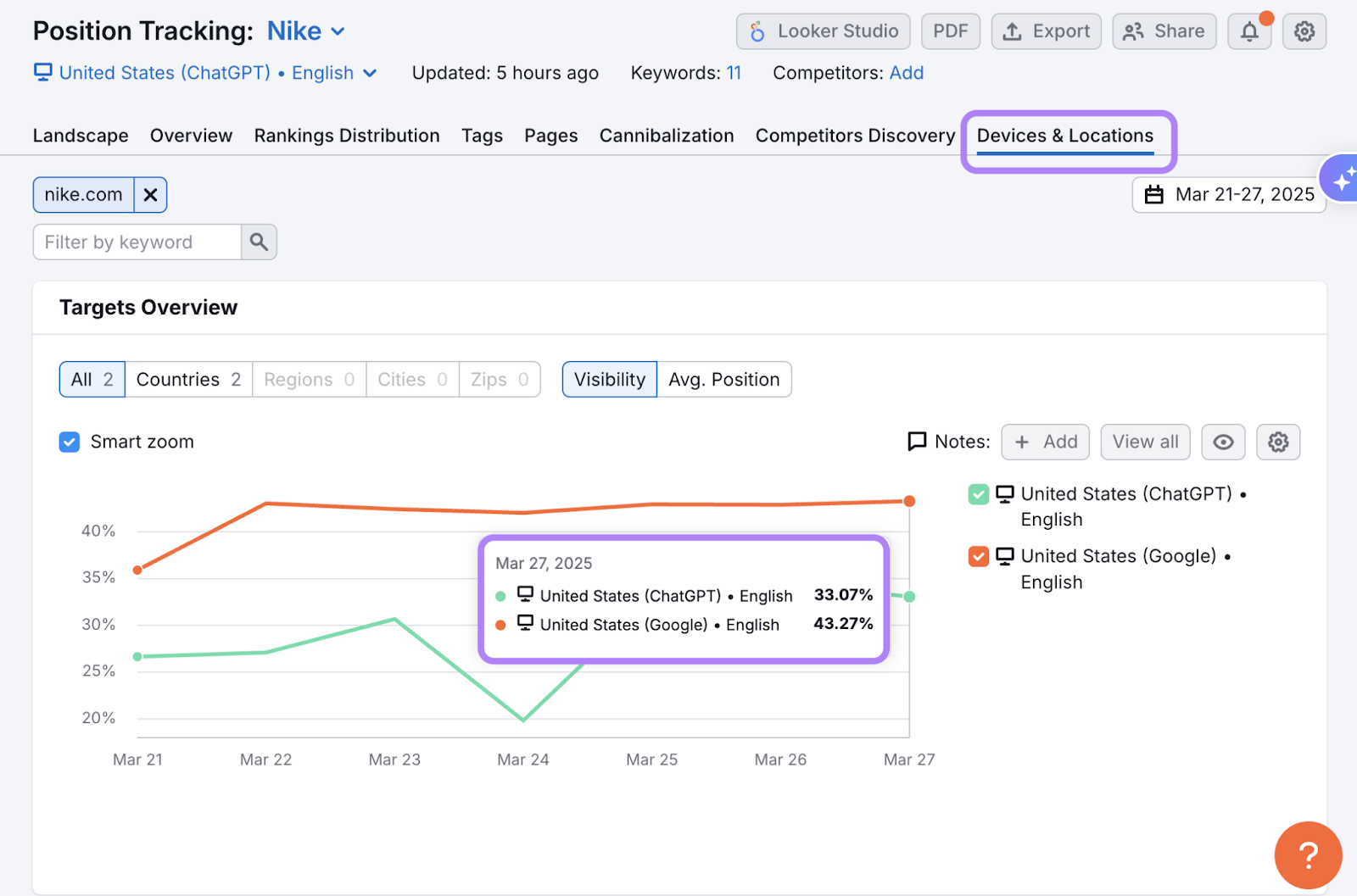
Once you understand how your site performs on different devices, it’s a good idea to see how you stack up against your competition.
Position Tracking reveals who's taking the search visibility you want and why.
Identify Competitors with Competitors Discovery
You might think you know who your competitors are, but search engines could tell a different story.
Imagine you sell handmade soap. You might consider other local soap makers as competitors, but online, you could be competing with big stores like Bath & Body Works or even Amazon listings.
Position Tracking automatically finds websites that rank for the same keywords as you, helping you:
- Discover your real competitors you didn't know about
- See which sites outrank you for important keywords
- Analyze the content on the sites that outrank you
- Track when competitors' rankings change
Here’s how to use it:
Go to the "Competitors Discovery" tab in your campaign.
By default, this map will show the top 10 domains competing for your keywords in the top 100 results. However, you can adjust the depth of competitors at any time.
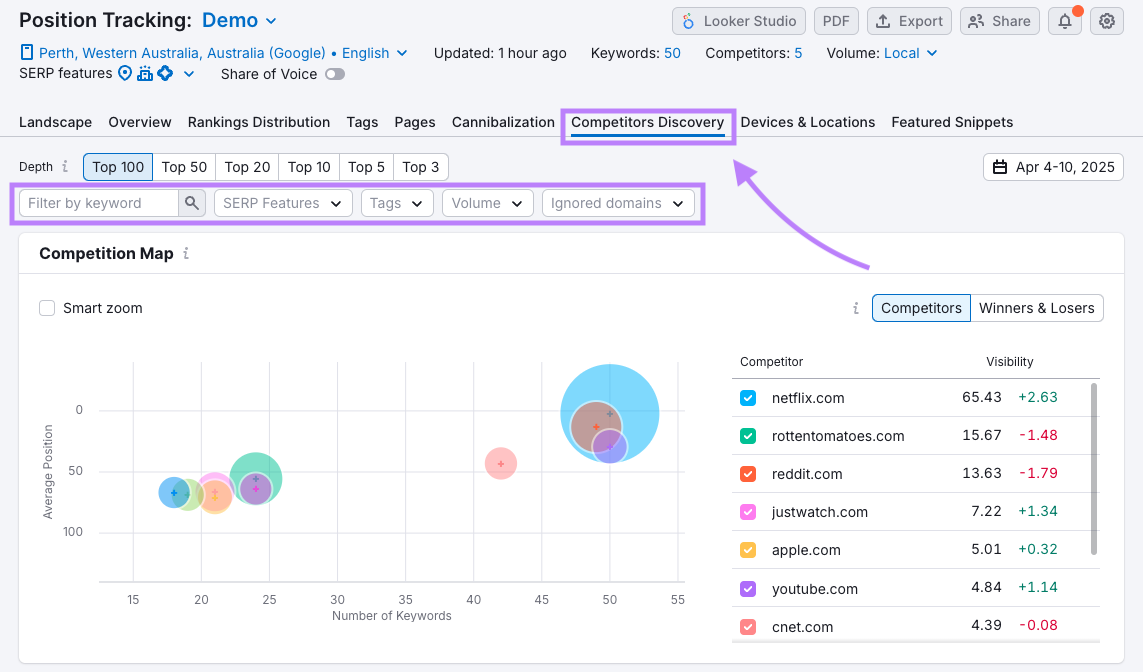
You can also filter the competition map by SERP Features, tags, volume, etc. This will show you who is competing with you the most for keywords that have local pack results, reviews, videos, featured snippets, and more.
Or, scroll down to see the list of websites ranking for your keywords.
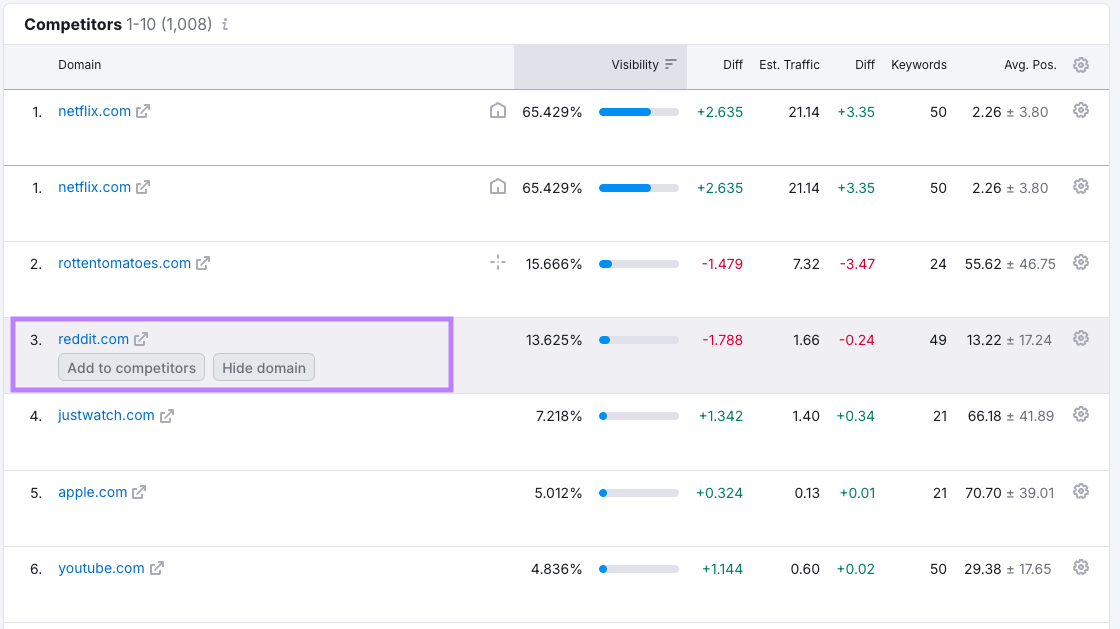
Hover over a competitor to add the ones that matter most. Or use "Hide domain" to ignore websites that aren't realistic competition.
Keep in mind, though, that sometimes the competition comes from within your own website. This happens through keyword cannibalization.
Spot Keyword Cannibalization Issues
Have you ever competed against yourself without realizing it? That's what happens when you have more than one page competing for the same search traffic.
Imagine you have two separate blog posts on basically the same topic. One is titled “Chocolate Chip Cookie Recipe,” and the other is "How to Make Chocolate Chip Cookies."
Google gets confused about which page to show in search results, so neither page ranks as well as it could.
The Cannibalization report in Position Tracking can help. It allows you to:
- Find keywords where multiple pages on your site are competing
- See how these pages flip-flop in rankings
- Figure out which page should be the main one for each keyword
Go to the "Cannibalization" tab in Position Tracking.
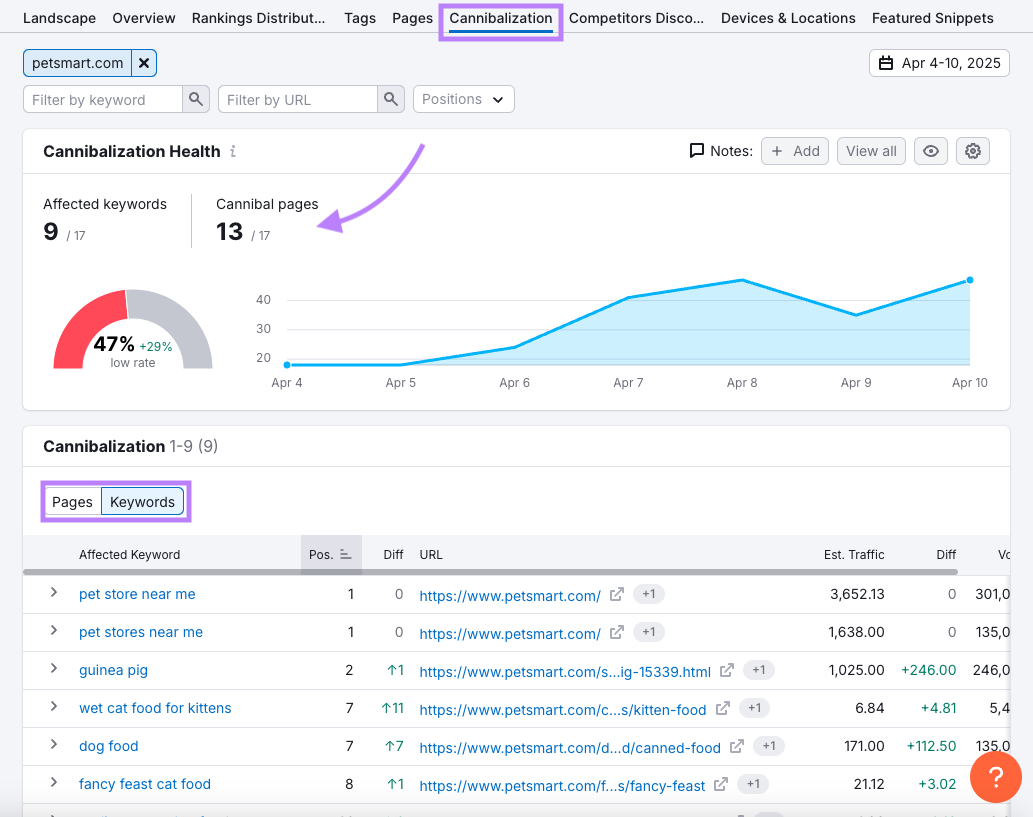
Here you can see:
- Affected Keywords: The number of keywords in your Position Tracking campaign where two or more of your pages are competing against each other within Google’s Top-100 organic search results.
- Cannibalizing Pages: The number of pages that appear in Google’s Top-100 organic results for each affected keyword.
Click “Keywords” in the Cannibalization table to review terms where multiple pages from your site appear.
For each conflicting keyword, choose which page should be the primary ranking candidate and optimize accordingly. This should be the page that is most relevant to the keyword.
Once you've streamlined your site's keyword strategy to understand external and internal competition, consider optimizing for new visibility opportunities in the SERP features.
Track & Optimize for SERP Features
Remember back when Google search results were just ten blue links on a page?
We all know that’s not the case anymore, so your SEO tracking should reflect that.
The most valuable real estate isn’t always the first organic position. Sometimes, it's the SERP features at the top, like featured snippets, the local map pack, or other special features that grab users' attention first.
Position Tracking helps you identify and capitalize on these opportunities.
Filtering by SERP Feature
The Position Tracking tool can filter your reports for over 20 SERP features, including:
- Featured Snippets
- Local Packs
- AI Overviews
- Reviews
- Videos or Featured Videos
- People Also Ask
- Images
- Instant Answers
- Knowledge Panels
Identify the Keywords that Trigger SERP Features
First, check which keywords in your campaign trigger SERP features to see where you should focus your efforts.
Choose in the SERP Features drop-down menu → “Feature on SERP” → select the target feature (for example, AI Overviews).
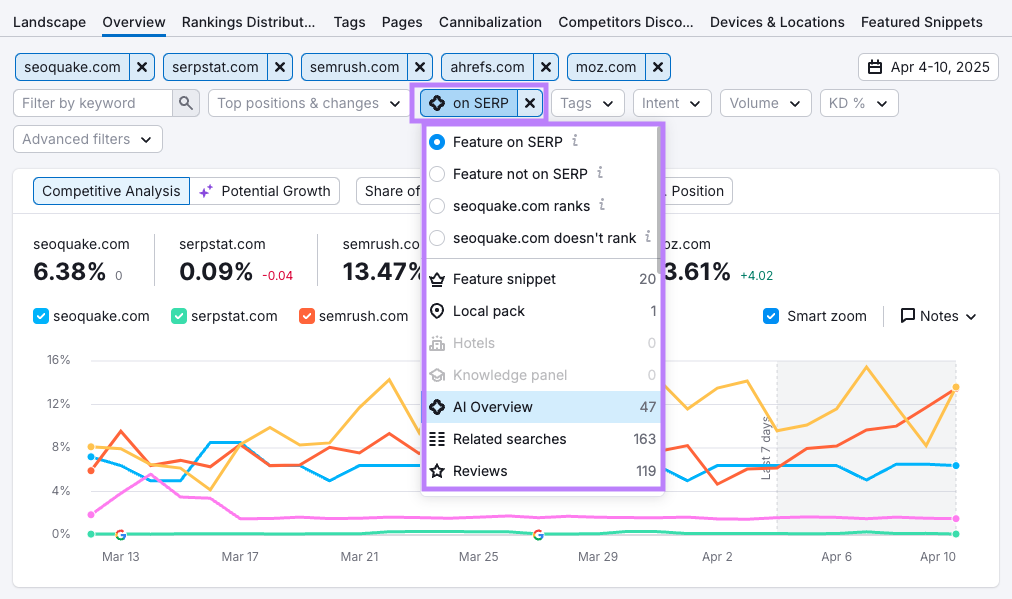
Scroll down to see which keywords trigger AI Overviews and whether your site is included as a source.
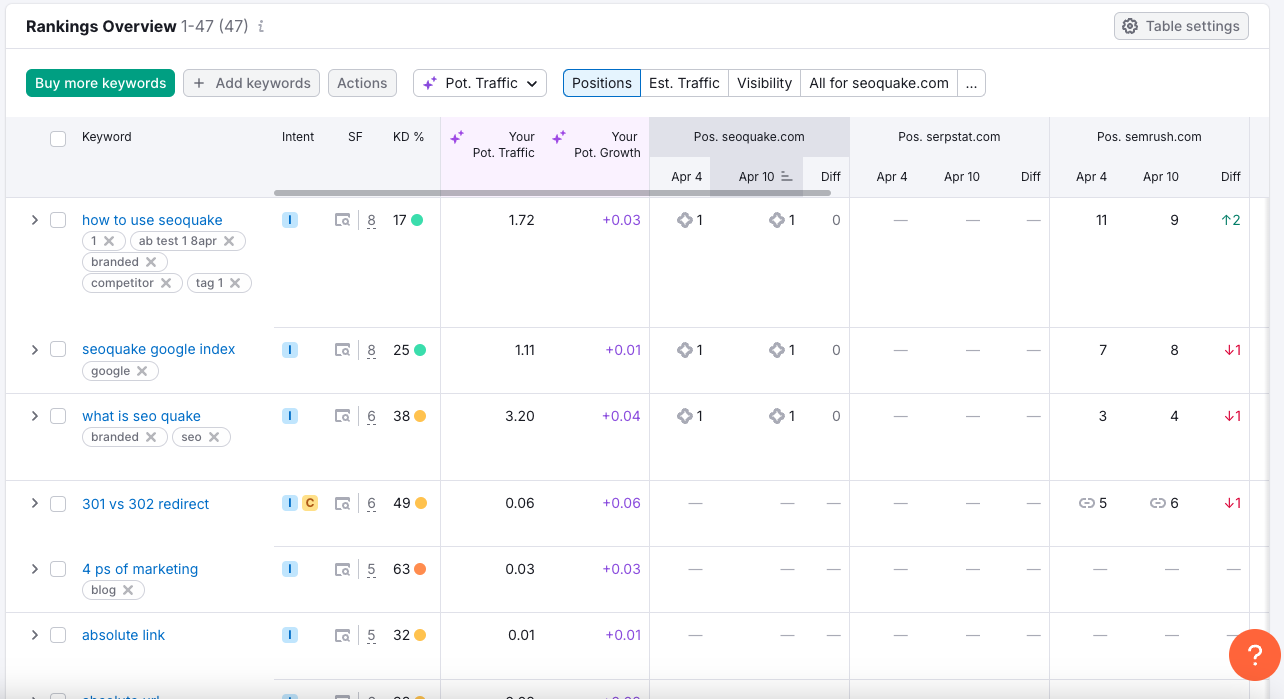
Analyze Your Competitors in SERP Features
Next, checkwhich of your rivals occupy the SERP feature.
There will be times that you will see a competitor giant in a SERP feature, and you won’t have a chance to move it. Don’t give up — find those queries where you have a fighting chance to win.
For example, set your domain as the first in the top menu, choose in the SERP Features drop-down menu → “your domain doesn’t rank” → select the target feature.
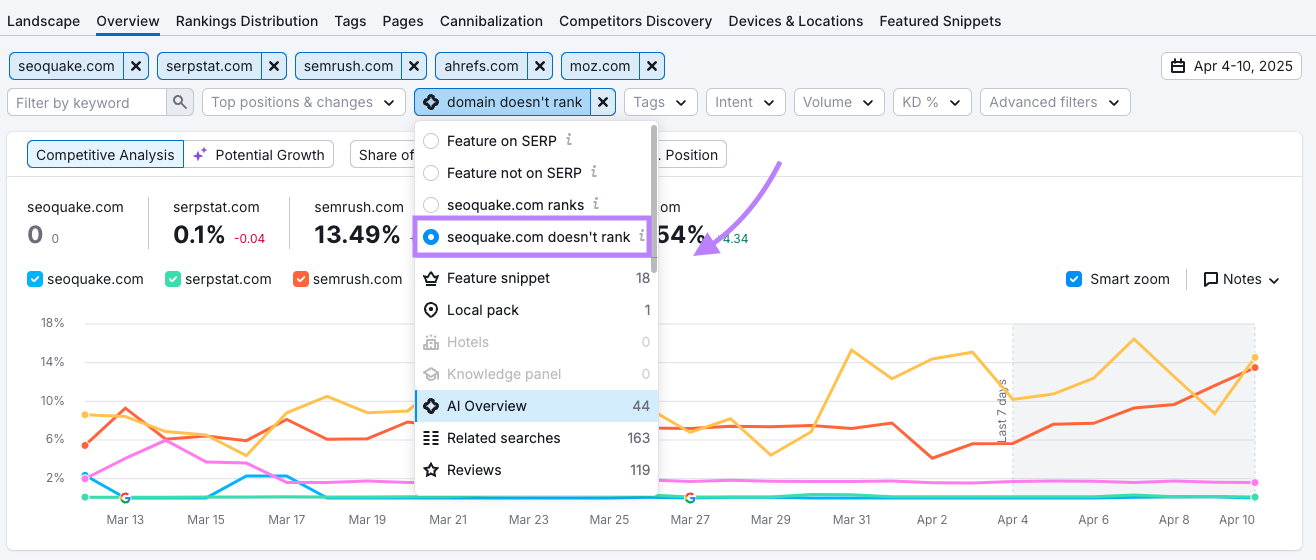
Analyze the content of the pages ranking.
Look for where your page could offer more up-to-date information, giving you a chance to outrank them.
Monitor the SERP Features You’ve “Won”
Finally, monitor where you’ve managed to earn a SERP feature. This is a good way to show your client or boss that your strategy is working.
Set your domain as the first in the top menu, choose in the SERP Features drop-down menu → “your domain ranks” → select the target feature.

Check out our blog post on how the Semrush toolkit can help you win SERP features if you want to learn more.
Organize Your Reporting with Tags
Imagine working on the SEO of an online store that offers a large assortment of goods. You’d be tracking thousands of keywords for various product categories, locations, seasonal occasions, genders, ages, and colors.
To avoid losing your sanity in a massive and unorganized mess, use tags. Assign the categories to your groups of keywords, and you can easily sort them at any time while looking at your reports.
Tags can be added from the initial setup window or at any point while your campaign is running by opening the Position Tracking settings menu.

With tags, you can:
- Create groups for different product lines, services, or content categories
- Filter reports by tag to report on specific segments or marketing campaigns
- Track the performance of service groups separately
How to create and use tags:
Select keywords in your campaign and click “Add tag.”

Customize Alerts and Reporting
Eager to see the fruits of your SEO labors?
Set up customized alerts to stay in the know at all times. Then, set up easy and detailed PDF reports and dashboards to showcase your results.
Set up alerts to:
- Get notified when rankings drop below a certain threshold
- Celebrate when you reach top positions
- Stay informed about competitors' ranking changes
To configure alerts, click on the “bell” button in your campaign.
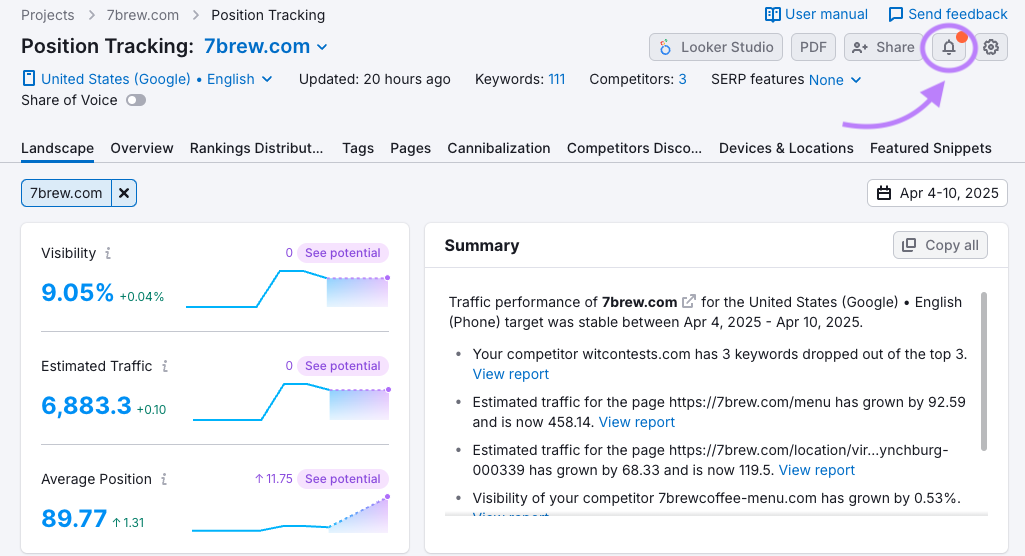
Choose your trigger conditions and notification preferences.

Save precious time by reviewing an important change when it happens.
Create Clean PDF Reports and Dashboards
Numbers tell the story, but a clean report presents it in high definition.
Semrush’s Position Tracking simplifies this with automated, attractive PDF reports that:
- Showcase ranking improvements over time
- Compare performance against competitors
- Provide regular updates without manual work
How to generate PDF reports:
Click the "PDF" button in any Position Tracking tab.
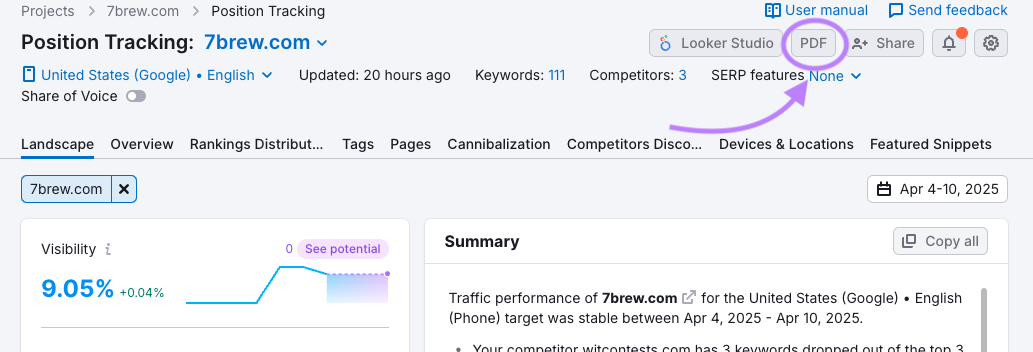
Choose the “Create online dashboard” option to make a shareable dashboard that can be accessed via a link.
Choose to email, schedule, or download the report.

Customize it with your logo and contact information.
Set up recurring reports for weekly or monthly delivery.

You can use the report builder to customize your report with formatting, integrations, and even AI summaries to make the best reports for your clients and leadership.
Integrate with Google Looker Studio
For more advanced visualization and reporting, you can connect Position Tracking data to Google Looker Studio with a Guru subscription or higher.
By combining your ranking data with other key marketing metrics, such as Google Analytics traffic or conversion data, you gain a comprehensive view of how SEO influences your business outcomes.
This integration allows you to:
- Create custom visualizations beyond standard reports
- Combine ranking data with other marketing metrics
- Build interactive dashboards for clients or teams
How to connect to Looker Studio:
Click on “Looker Studio” and choose the report you want to integrate with Looker Studio.
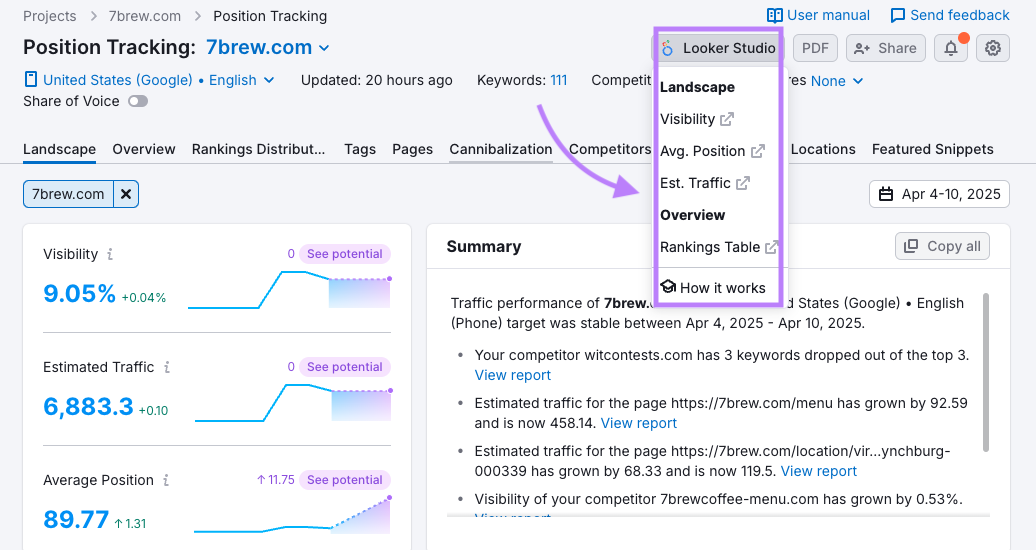
Follow the automatic connection process and design your custom dashboard with Position Tracking metrics, which could end up looking something like this:
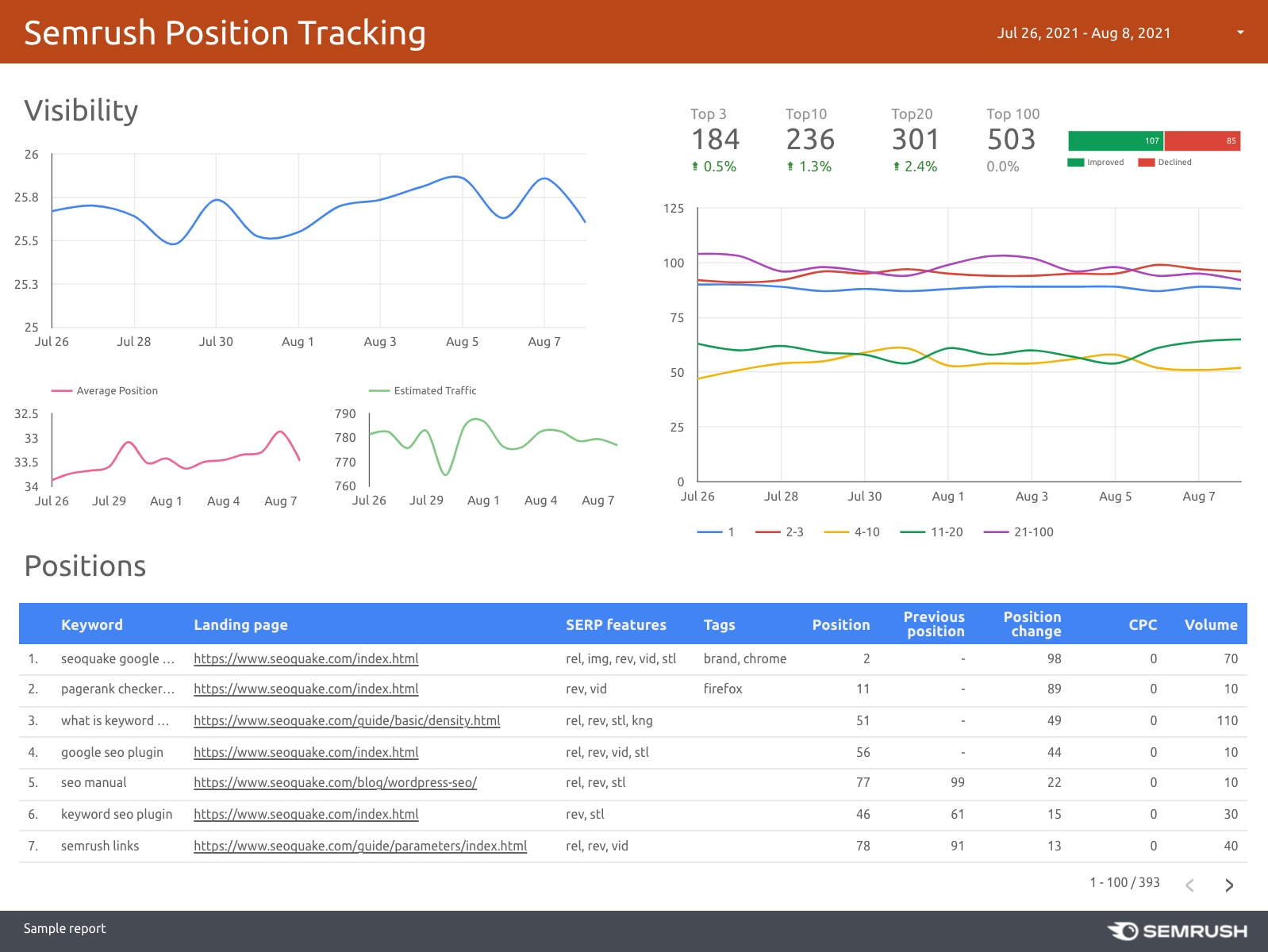
Start Tracking Your Rankings Today
Knowing where your website ranks in search results is the first step to improving those rankings.
Instead of spending hours manually checking search positions (and still getting incomplete data), let Position Tracking do the work while you focus on strategy and optimization.
Ready to see your true rankings?